Length 48 m Cruise speed 850 km/h Introduced February 1972 Engine type Turbofan | Top speed 950 km/h Wingspan 38 m Unit cost 45,000,000–45,000,000 USD | |
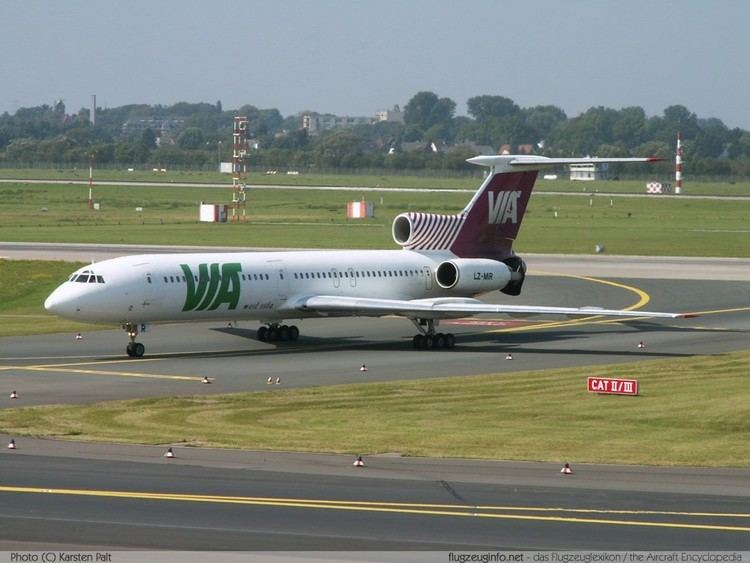 | ||
Russian airliner tupolev tu 154 airplane flight control problems
The Tupolev Tu-154 (Russian: Tyполев Ту-154; NATO reporting name: Careless) is a three-engine medium-range narrow-body airliner designed in the mid-1960s and manufactured by Tupolev. A workhorse of Soviet and (subsequently) Russian airlines for several decades, it carried half of all passengers flown by Aeroflot and its subsidiaries (137.5 million/year or 243.8 billion passenger km in 1990), remaining the standard domestic-route airliner of Russia and former Soviet states until the mid-2000s. It was exported to 17 non-Russian airlines and used as head-of-state transport by the air forces of several countries.
Contents
- Russian airliner tupolev tu 154 airplane flight control problems
- Development
- Design
- Variants
- Current operators
- Former civil operators
- Former military operators
- Incidents and accidents
- Preserved aircraft
- In popular culture
- References
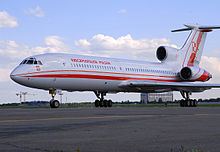
With a cruising speed of 900 kilometres per hour (560 mph) the Tu-154 is one of the fastest civilian aircraft in use and has a range of 5,280 kilometres (3,280 mi). Capable of operating from unpaved and gravel airfields with only basic facilities, it was widely used in the extreme Arctic conditions of Russia's northern/eastern regions where other airliners were unable to operate. Originally designed for a 45,000 hour service life (18,000 cycles) but capable of 80,000 hours with upgrades, it is expected to continue in service until 2016, although noise regulations have restricted flights to western Europe and other regions.

In January 2010 Russian flag carrier Aeroflot announced the retirement of its Tu-154 fleet after 40 years with the last scheduled flight being Aeroflot Flight 736 from Ekaterinburg to Moscow on 31 December 2009.
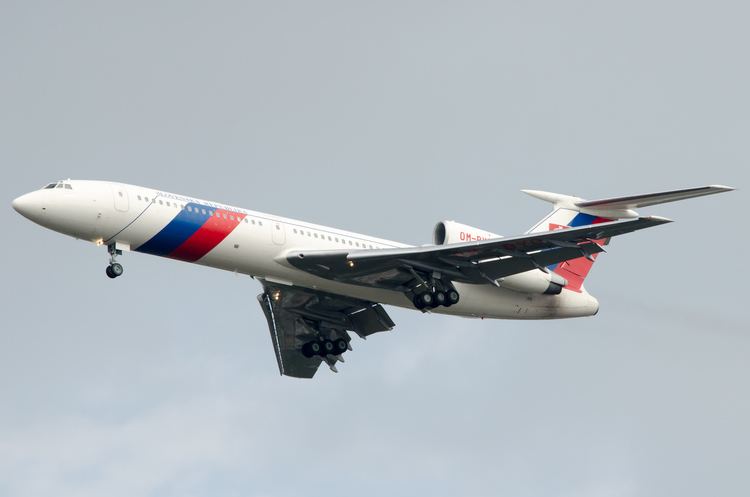
Since 1968 there have been 39 fatal incidents involving the Tu-154, most of which were caused either by factors unrelated to the aircraft, or by its extensive use in demanding conditions.
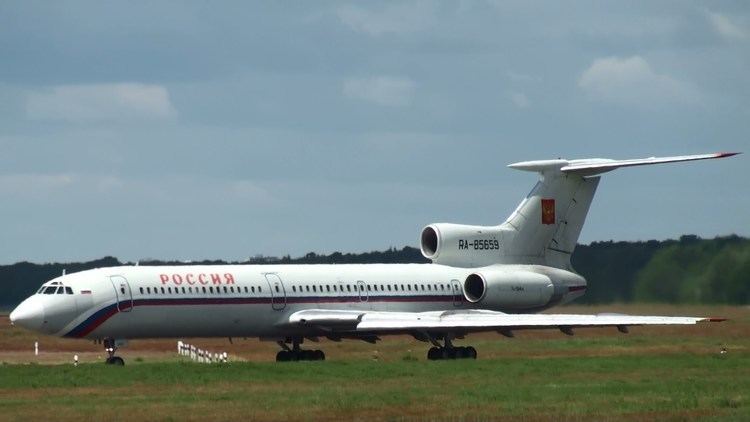
Following a crash in 2016 all Tupolev Tu-154 aircraft in Russia were grounded. However, the Tu-154 is still being used as of January 2017.
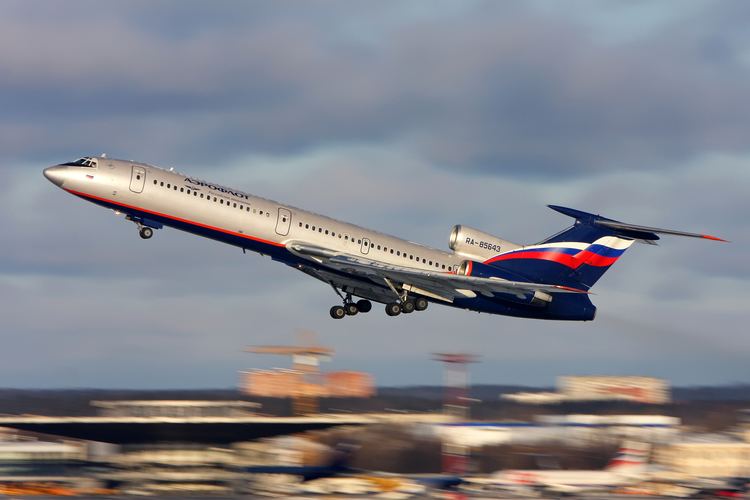
Development
The Tu-154 was developed to meet Aeroflot's requirement to replace the jet-powered Tu-104, the Antonov An-10 and the Ilyushin Il-18 turboprops. The requirements called for either a payload capacity of 16–18 tonnes (35,000–40,000 lb) with a range of 2,850–4,000 kilometres (1,770–2,490 mi) while cruising at 900 km/h (560 mph), or a payload of 5.8 tonnes (13,000 lb) with a range of 5,800–7,000 kilometres (3,600–4,300 mi) while cruising at 850 km/h (530 mph). A take-off distance of 2,600 metres (8,500 ft) at maximum take-off weight was also stipulated as a requirement. Conceptually similar to the British Hawker Siddeley Trident, which first flew in 1962, and the American Boeing 727, which first flew in 1963, the medium-range Tu-154 was marketed by Tupolev at the same time as Ilyushin was marketing the long-range Ilyushin Il-62. The Soviet Ministry of Aircraft Industry chose the Tu-154 as it incorporated the latest in Soviet aircraft design and best met Aeroflot's anticipated requirements for the 1970s and 1980s.
The first project chief was Sergey Yeger; in 1964, Dmitryi S. Markov assumed that position. In 1975, the project lead role was turned over to Aleksandr S. Shengardt.
The Tu-154 first flew on 4 October 1968. The first deliveries to Aeroflot were in 1970 with freight (mail) services beginning in May 1971 and passenger services in February 1972. There was still limited production of the 154M model as of January 2009 despite previous announcements of the end of production in 2006. 1025 Tu-154s have been built, 214 of which were still in service as of 14 December 2009. The last serial Tu-154 was delivered to the Russian Defense Ministry on 19 February 2013 from the Aviakor factory, equipped with upgraded avionics, a VIP interior and a communications suite. The factory has four unfinished hulls in its inventory which can be completed if new orders are received.
Design
The Tu-154 is powered by three rear-mounted low-bypass turbofan engines arranged similarly to those of the Boeing 727, but it is slightly larger than its American counterpart. Both the 727 and the Tu-154 use an S-duct for the middle (Number 2) engine. The original model was equipped with Kuznetsov NK-8-2 engines, which were replaced with Soloviev D-30KU-154 in the Tu-154M. All Tu-154 aircraft models have a relatively high thrust-to-weight-ratio which gave excellent performance, at the expense of lower fuel efficiency. This became an important factor in later decades as fuel costs grew.
The flight deck is fitted with conventional dual yoke control columns. Flight control surfaces are hydraulically operated.
The cabin of the Tu-154, although of the same six-abreast seating layout, gives the impression of an oval interior, with a lower ceiling than is common on Boeing and Airbus airliners. The passenger cabin accommodates 128 passengers in a two-class layout and 164 passengers in single-class layout, and up to 180 passengers in high-density layout. The layout can be modified to what is called a winter version where some seats are taken out and a wardrobe is installed for passenger coats. The passenger doors are smaller than on its Boeing and Airbus counterparts. Luggage space in the overhead compartments is very limited.
Like the Tupolev Tu-134, the Tu-154 has a wing swept back at 35° at the quarter-chord line. The British Hawker Siddeley Trident has the same sweepback angle, while the Boeing 727 has a slightly smaller sweepback angle of 32°. The wing also has anhedral (downward sweep) which is a distinguishing feature of Russian low-wing airliners designed during this era. Most Western low-wing airliners such as the contemporary Boeing 727 have dihedral (upward sweep). The anhedral means that Russian airliners have poor lateral stability compared to their Western counterparts, but also have weaker Dutch roll tendencies.
Considerably heavier than its predecessor Soviet-built airliner the Ilyushin Il-18, the Tu-154 was equipped with an oversized landing gear to reduce ground load, enabling it to operate from the same runways. The aircraft has two six-wheel main bogies fitted with large low-pressure tires that retract into pods extending from the trailing edges of the wings (a common Tupolev feature), plus a two-wheel nose gear unit. Soft oleo struts (shock absorbers) provide a much smoother ride on bumpy airfields than most airliners, which very rarely operate on such poor surfaces.
The original requirement was to have a three-person flight crew – captain, first officer and flight engineer – as opposed to a four- or five-person crew, like on other Soviet airliners. It became evident that a fourth crew member, a navigator, was still needed, and a seat was added on production aircraft, although their workstation was compromised due to the limitations of the original design. Navigators are no longer trained and this profession is becoming obsolete with the retirement of older Soviet-era planes.
The latest variant (Tu-154M-100, introduced 1998) includes an NVU-B3 Doppler navigation system, a triple autopilot, which provides an automatic ILS approach according to ICAO category II weather minima, an autothrottle, a Doppler drift and speed measure system (DISS), and a "Kurs-MP" radio navigation suite. A stability and control augmentation system improves handling characteristics during manual flight. Modern upgrades normally include a TCAS, GPS and other modern systems, mostly American or EU-made.
Early versions of the Tu-154 cannot be modified to meet the current Stage III noise regulations and are banned from flying where those regulations are in force, such as the European Union.
Variants
Many variants of this airliner have been built. Like its western counterpart, the 727, many of the Tu-154s in service have been hush-kitted, and some converted to freighters.
Current operators
As of February 2017, there are 45 Tupolev Tu-154 aircraft of all variants still in civil or military service. The remaining operators are:
In February 2011, all remaining Iranian Tu-154s were grounded after two incidents.
On 27 December 2016, the Russian Ministry of Defence announced that it had grounded all of its Tu-154s until the end of the investigation into the December 2016 crash of a 1983 Tupolev Tu-154. This was followed by the grounding of all Tu-154s in Russia. The Tu-154 had crashed into the Black Sea just after takeoff from Sochi, Russia, on 25 December 2016 killing all 92 people on board, including 64 members of the Alexandrov Ensemble, an official army choir of the Russian Armed Forces. The Red Army Choir singers and dancers were en route to Syria to entertain Russian troops in the run-up to the New Year.
Former civil operators
Former military operators
Incidents and accidents
Between 1970 and December 2016 there have been 110 serious incidents involving the Tu-154, and 69 hull losses, 30 of which did not involve fatalities. Of the fatal incidents, five resulted from terrorist or military terrorist action (two other war-time losses were non fatal), several from poor runway conditions in winter (including one in which the airplane struck snow plows on the runway), cargo overloading in the lapse of post-Soviet federal safety standards, and mid-air collisions due to faulty air traffic control. Other incidents resulted from mechanical problems (two cases prior to 2001), running out of fuel on unscheduled routes, pilot errors (including inadequate flight training for new crews), and cargo fires; several accidents remain unexplained.
The Tu-154 is described as having an average (or better than expected) safety record considering its length of service and heavy use in demanding conditions where other airliners are unable to operate. On January 2, 2011, Russia's Federal Transport Oversight Agency advised airlines to stop using remaining examples of the Tu-154 (B variant) until the fatal fire incident in Surgut had been investigated. Its operation in Iran ceased in February 2011 due to a number of crashes and incidents involving the type (almost 9% of all Tu-154 losses have occurred in Iran). This grounding compounded the effects of US embargo on civil aircraft parts, substantially decreasing the number of airworthy aircraft in the Iranian civil fleet. In 2010 there were two fatal losses of the Tu-154 due to pilot error and/or weather conditions (a Polish presidential jet attempting a rural airfield landing in heavy fog, the 2010 Polish Air Force Tu-154 crash, and a Russian-registered plane that suffered engine stall after a crew member accidentally de-activated a fuel transfer pump). Following these accidents, in March 2011 the Russian Federal Bureau of Aviation recommended a withdrawal of remaining Tu-154Ms from service. In December 2010, Uzbekistan Airways also declared that it will cease to operate Tu-154s from 2011.
On 27 December 2016, the Russian Defence Ministry grounded all Tu-154s in Russia pending investigation into the 25 December 2016 Tupolev Tu-154 crash which killed 64 members of the Alexandrov Ensemble, an official Red Army Choir of the Russian Armed Forces.
